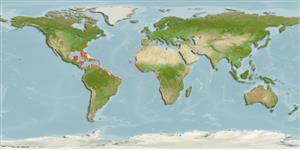Common names from other countries
Environment: milieu / climate zone / depth range / distribution range
Ecologia
marinhas; estuarina associadas(os) a recifes; intervalo de profundidade 0 - 5 m (Ref. 3723). Subtropical; 41°N - 13°S, 98°W - 14°E
Western Atlantic: New York, USA and northern Gulf of Mexico to Brazil (Ref. 7251); including the Caribbean Sea (Ref. 3723). Eastern Atlantic: from Morocco to the Canary Islands (Ref. 57227) and in the Gulf of Guinea from Victoria, Nigeria to south to Luanda, Angola (Ref. 4497). Reported from Côte d'Ivoire (Ref. 28587, 57227).
Tamanho / Peso / Idade
Maturity: Lm ? range ? - ? cm
Max length : 40.0 cm TL macho/indeterminado; (Ref. 3633); common length : 35.0 cm TL macho/indeterminado; (Ref. 3633)
Espinhos dorsais (total): 0; Raios dorsais (total): 11-15; Espinhos anais 0; Raios anais : 10 - 13. Diagnosis: body elongate; lower jaw forming long, narrow beak; upper jaw short, triangular and scaled; absence of scales on snout; no preorbital crest between eye and nasal pit; pelvic fins abdominal; dorsal and anal fins placed far back on body and spineless; caudal fin deeply forked (Ref. 57227).
An inshore, surface-dwelling fish which forms sizeable schools (Ref. 3723). Feeds on small fishes and plankton (Ref. 3723). Mainly used as bait for offshore game fishes such as sailfishes and marlins; utilized as a food fish in the West Indies (Ref. 3723). Minimum depth range from Ref. 84211.
Ciclo de vida ou comportamento de acasalamento
Maturidade | Reprodução | Desova | Ovos | Fecundidade | Larvas
Collette, B.B. and N.V. Parin, 1990. Hemiramphidae. p. 579-582. In J.C. Quero, J.C. Hureau, C. Karrer, A. Post and L. Saldanha (eds.) Check-list of the fishes of the eastern tropical Atlantic (CLOFETA). JNICT, Lisbon; SEI, Paris; and UNESCO, Paris. Vol. 2. (Ref. 4497)
Status na Lista Vermelha da UICN (Ref. 130435)
CITES (Ref. 128078)
Not Evaluated
Ameaça para os humanos
Harmless
Uso pelos humanos
Pescarias: pouco comercial; isca: usually
Mais informação
ReferênciasAquaculturaPerfil para aquaculturaEstirpesGenéticaElectrophoresesHereditariedadeDoençasProcessamentoConversão de massa
ColaboradoresFotosStamps, Coins Misc.SonsCiguateraVelocidadeTipo de nataçãoÁrea branquialOtólitosCérebrosVisão
Ferramentas
Relatórios especiais
Baixar XML
Fontes da internet
Estimates based on models
Preferred temperature (Ref.
115969): 21.1 - 28.1, mean 27.2 (based on 1007 cells).
Índice de diversidade filogenética (Ref.
82804): PD
50 = 0.5005 [Uniqueness, from 0.5 = low to 2.0 = high].
Bayesian length-weight: a=0.00339 (0.00169 - 0.00679), b=3.09 (2.92 - 3.26), in cm Total Length, based on LWR estimates for this species & Genus-body shape (Ref.
93245).
Nível Trófico (Ref.
69278): 3.9 ±0.3 se; based on diet studies.
Resiliência (Ref.
120179): Elevada, tempo mínimo de duplicação da população menor que 15 meses (Preliminary K or Fecundity.).
Fishing Vulnerability (Ref.
59153): Low to moderate vulnerability (30 of 100).
